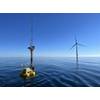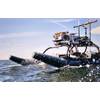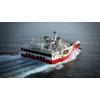Moody's Reviews Saipem's Rating
San Donato Milanese (Milan), February 10, 2016 – Saipem S.p.A., informs that today Moody’s, through the publication of a press release on its website [www.moodys.com] given below has communicated that it has placed under review the provisional issuer rating of "(P) Baa3 " attributed to Saipem, for a possible downgrade.
Moody’s decision, which follows the one by Standard & Poor’s on February 4th 2016, is substantially based on the same considerations:
• On the recent weakening of industry fundamentals and the consequent increase in the risk of project cancellations and/or delays and reduced capital spending by oil & gas companies
• On the deterioration in the oil-price scenario which has occurred since October 2015, when
Saipem was assigned its provisional rating, and which has caused Moody’s to downgrade its expectations for future oil prices.
• On the potential impact of the weaker market context on Saipem’s future ability to generate cashflows in line with the strategic plan.
In light of these considerations, Moody's will conduct an in-depth analysis over the next couple of months, assessing Saipem's ability to manage this industry downturn and the relative impacts on the backlog and financial results before reaching a decision on the potential downgrade.
RATINGS RATIONALE
Today's review for downgrade considers that much weaker industry fundamentals increase the risk of project cancellations and delays and reduced capital spending in the oil and gas sector and have the potential to warrant a rating change for Saipem.
Oil prices have deteriorated substantially since Moody's assigned a provisional (P)Baa3 Issuer Rating to Saipem in October and have reached nominal price lows not seen in more than a decade. Moody's has adjusted its view downward for the likely range of prices. We see a substantial risk that prices may recover much more slowly over the medium term than many companies expect, as well as a risk that prices might fall further. Even under a scenario with a modest recovery from current prices, producing companies and the drillers and service companies that support them will experience rising financial stress with much lower cash flows.
Saipem's backlog stood at a significant €19 billion as of 1H 2015. Although this declined to €17.8 billion as of 3Q 2015 due to a lack of significant new wins in the quarter and the cancellation of the €1.2 billion South Stream contract, it also excludes in excess of €600 million of new engineering and construction (E&C) offshore contracts announced in Q4 2015. This €18 billion contracted revenue backlog provides some visibility into 2017 for both the E&C and drilling businesses, with €2.5 billion to be realized in 2015, €7.6 billion in 2016 and €7.7 billion thereafter.
However, Moody's now expects oil prices to remain below $45 through 2018, with only a gradual recovery from current levels around $30 and so expects continued pressure from Saipem's large National Oil Company (NOC) and IOC clients both in terms of pricing and simply delaying awards of both E&C projects and drilling programmes, with the potential for some existing awards to be rephased or even cancelled. On the other hand, Saipem has significant presence in the Middle East, which accounts for 35% of 3Q 2015 backlog and is showing some resilience in the current weak oil price environment.
For the offshore drilling industry, Moody's expects the strong negative trends will remain deeply entrenched for the next several years and drillers' contracted revenue backlogs, fleet utilization and cash flows will continue to slide. With approximately 50% of floaters and 70% of jack-ups contracted at year-end 2016 and only 25% of floaters and 43% of jack-ups by the end of 2017, Saipem's fleet has a similar contracted picture to many in the offshore drilling industry. There have also been contract terminations, with TOTAL S.A. (Aa1 review for downgrade) terminating its lease of the Saipem 12000 drillship for convenience and Statoil ASA (Aa2 review for downgrade) suspending the lease for the Scarabeo 5 semi-submersible. In this context, several of Saipem's older floaters will find it challenging to re-contract in 2016-2017 and will likely have to be scrapped. On the land drilling side, although Moody's expects continued work in the Middle East, as reflected in Saipem's recent award in Kuwait, many of Saipem's land rigs that roll off contract in Venezuela may not be re-contracted due to Petroleos de Venezuela, S.A.'s (Caa3 stable) weak financial position, despite the Venezuelan state's need to continue to pump oil to generate revenue. Moreover, Venezuela will likely continue to delay payments of receivables.
At the time of the initial provisional rating assignment, Moody's had expected Saipem would still have a leveraged credit profile even after paying down debt post raising equity, with Moody's gross adjusted leverage based on our projections for FY2016-17 of between 3.0-3.5x, which was seen as weak for an investment grade construction company. This leverage range was based on Moody's expectation of a reported EBITDA between €1.0-€1.1 billion in 2016, which the rating agency expected to fall slightly in 2017. Moody's debt adjustments add capitalized leases (using a three times multiple, consistent with other companies in the construction industry), pensions and drawing under a factoring facility. This assessment was more conservative than Saipem's public business plan targets at the time: of EBIT of approximately €700 million in 2017, with a net financial position of less than €1.0 billion, moving to net cash in 2019.
However, as a result of the scale of the change in our oil price deck for 2016, 2017 and 2018, Moody's now expects it is more likely that Saipem will underperform what at the time was a conservative Moody's base case and might breach one or more of the triggers to downgrade the rating.
In light of these adverse industry developments and the likely prolonged nature of this challenging operating environment, there is a substantial risk of a rating downgrade. Moody's will conduct an in-depth analysis over the next couple of months and reach a rating conclusion based on our view of Saipem's projected financial performance and ability to navigate this industry downturn.
Against this background, Moody's review will assess (i) the company's order backlog and intake and bidding pipeline, (ii) execution track record including progress on loss making contracts, (iii) earnings, cash flow generation and leverage going forward, including impacts of any additional disposals or cost cutting, (iv) management's strategic objectives and financial policy considering the investment grade rating might now be downgraded, (v) progress on the equity raising and refinancing and (vi) liquidity and refinancing risk associated with the bridge to bond facility that matures by 2018 at the latest.
WHAT COULD CHANGE THE RATING UP/DOWN
As Saipem's provisional rating has been placed under review for downgrade, an upgrade of the rating is unlikely in the medium-term. That said, over time Saipem's ratings could upgraded if it maintains a strong order backlog and conditions improve in the oil and gas markets leading to it sustaining: (i) EBITA over $750 million, (ii) FFO/debt above 30%, and (iii) Moody's adjusted gross leverage is sustained below 2.5x, while maintaining good liquidity and the company builds a good execution track record. Moody's had previously stated that Saipem's provisional rating could be downgraded, if (i) Saipem issues less than €3.5 billion in equity to repay debt, (ii) Moody's were to conclude that Moody's adjusted gross leverage will remain over 3.5x, (iii) FFO/debt remains below the mid-twenties percentage or (iv) if liquidity deteriorates.
PRINCIPAL METHODOLOGY
The principal methodology used in this rating was Construction Industry published in November 2014. Please see the Ratings Methodologies page on www.moodys.com for a copy of this methodology.
Saipem, based in Milan, Italy is a leading engineering, construction and drilling company focussing on the oil and gas industry and specialising in remote areas and deepwater. It has a large offshore fleet of 30 construction vessels, 15 drilling rigs and 57 remotely operated vehicles (ROVs), capable of executing technologically difficult projects, as well as 10 fabrication yards and 111 onshore rigs, including 11 managed or under construction. As of the last-twelve-months to 30 September 2015, the company generated revenue of approximately €12 billion with a broad regional diversity across the world.
















 February 2024
February 2024



